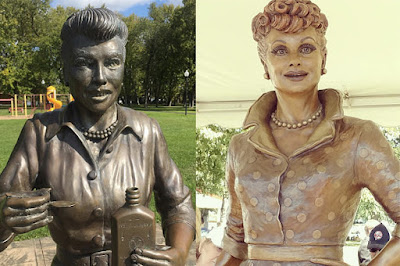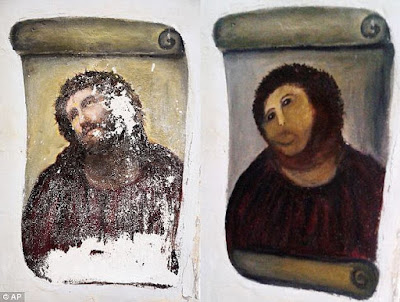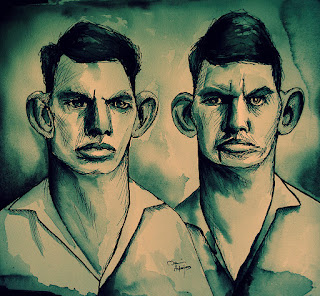(From Entertainment Weekly)
Since 2009, “Scary Lucy” has terrorized the small village of Celoron, New York, with square teeth and bugged-out eyes that suggest that, were she not captured in 400 pounds of bronze, she would love to pair your brains with her bottle of intoxicating Vitameatavegamin. Now that statue — which is generously considered to be a depiction of comedy legend Lucille Ball — will be replaced with another bronze sculpture, which presumably will not cause nightmares.
EW reports that the new sculpture, by artist Carolyn Palmer, will debut in Celoron, Ball’s hometown, on August 6. Palmer spent months watching I Love Lucy and studying pictures for the bronze piece. “I not only wanted to portray the playful, animated, and spontaneous Lucy,” Palmer explained, “but also the glamorous Hollywood icon.” At that time, the town will retire the “Scary Lucy” sculpture — which its creator, David Poulin, once diplomatically referred to as “by far my most unsettling sculpture.” You can see it below, and then never un-see it.
Since 2009, “Scary Lucy” has terrorized the small village of Celoron, New York, with square teeth and bugged-out eyes that suggest that, were she not captured in 400 pounds of bronze, she would love to pair your brains with her bottle of intoxicating Vitameatavegamin. Now that statue — which is generously considered to be a depiction of comedy legend Lucille Ball — will be replaced with another bronze sculpture, which presumably will not cause nightmares.
EW reports that the new sculpture, by artist Carolyn Palmer, will debut in Celoron, Ball’s hometown, on August 6. Palmer spent months watching I Love Lucy and studying pictures for the bronze piece. “I not only wanted to portray the playful, animated, and spontaneous Lucy,” Palmer explained, “but also the glamorous Hollywood icon.” At that time, the town will retire the “Scary Lucy” sculpture — which its creator, David Poulin, once diplomatically referred to as “by far my most unsettling sculpture.” You can see it below, and then never un-see it.
Update, August 6: The new, six-foot-tall bronze sculpture has been unveiled — and it's the vast, vast improvement that the comedy legend deserves. Today would've been Ball's 105th birthday.
OKAY! It's Monday morning, I have a bit of a headache (though not from what you're thinking - I never touch the stuff), and lo and behold, here's good news. They have finally replaced the horrific statue purported to be Lucille Ball which disgraced her home town for SEVEN years. One can only imagine the deep dismay of the crowd as it was unveiled - or perhaps they christened it by smashing a bottle of Vita-Meata-Vegamin over its head.
I've been sort of keeping track of this story, because it represents a certain kind of bizarre. It brings to mind another - shall we say - misportrait. A few years back, an old lady who was an amateur painter took it upon herself to "restore" a painting of Jesus called Ecce Homo in a tiny church in Spain. It was peeling badly, and at first she only dabbed paint on the robe, but then. . .
This was either genius (to some people), or disaster.
It looks about as much like Jesus as that first sculpture of Lucy. But then. . . do we really know what Jesus looked like?
Are we certain there WAS a Jesus? Having been a Christian for 15 years, then walked away in total disillusionment, I now believe he was a collection of stories half-based on truth, and the other half, hope. He was wished into being, which is maybe not such a bad thing unless you're expected to believe he literally existed.
In the United Church, they lowered the ante due to falling attendance, until the Moderator of the church admitted she didn't even believe in God, let alone Jesus. But she was still "spiritual" (though not "religious"). So baking brownies for the UCW was enough to make you a member, so long as you ponied up financially to the point of pain. If you didn't, guilt and accusations that you had no "commitment" would be laid on with a trowel.
It's enough to make you embrace the new, improved Ecce Homo. Some have called it "Icky Homo", and even worse things. For a while, it brought masses of tourists to the cathedral, a boon for the town. I think the crowds have likely fallen off by now. Fallen off the edge of the world, more like. The key chains, fridge magnets, tote bags, tshirts, water bottles and action figures are now moldering on the shelves, maybe in the bargain corner at the Vatican gift store.
Meantime, we have a new Lucy, and she is a big improvement, but I still don't think they got the face quite right. She had an unusual kind of beauty, and was one of the first glamorous women to do comedy. Phyllis Diller was more the norm. Women had to look hideous to be funny. When Ball first starred in I Love Lucy, she was 40 years old, which by the standards of the day was more like 60. Some years later, she had her first baby (Little Ricky!) - and was actually pregnant on the show. Kind of like the first reality TV.
She came back in various guises for years, not always successfully, but like the trooper she was, she kept on working 'til the end.
So the new statue: shall we call it a resurrection? Shall we melt down the bronze from Scary Lucy and make a Donald Trump, offering free rotten tomatoes to the crowd?
Just a thought.
I've been sort of keeping track of this story, because it represents a certain kind of bizarre. It brings to mind another - shall we say - misportrait. A few years back, an old lady who was an amateur painter took it upon herself to "restore" a painting of Jesus called Ecce Homo in a tiny church in Spain. It was peeling badly, and at first she only dabbed paint on the robe, but then. . .
This was either genius (to some people), or disaster.
It looks about as much like Jesus as that first sculpture of Lucy. But then. . . do we really know what Jesus looked like?
Are we certain there WAS a Jesus? Having been a Christian for 15 years, then walked away in total disillusionment, I now believe he was a collection of stories half-based on truth, and the other half, hope. He was wished into being, which is maybe not such a bad thing unless you're expected to believe he literally existed.
In the United Church, they lowered the ante due to falling attendance, until the Moderator of the church admitted she didn't even believe in God, let alone Jesus. But she was still "spiritual" (though not "religious"). So baking brownies for the UCW was enough to make you a member, so long as you ponied up financially to the point of pain. If you didn't, guilt and accusations that you had no "commitment" would be laid on with a trowel.
It's enough to make you embrace the new, improved Ecce Homo. Some have called it "Icky Homo", and even worse things. For a while, it brought masses of tourists to the cathedral, a boon for the town. I think the crowds have likely fallen off by now. Fallen off the edge of the world, more like. The key chains, fridge magnets, tote bags, tshirts, water bottles and action figures are now moldering on the shelves, maybe in the bargain corner at the Vatican gift store.
Meantime, we have a new Lucy, and she is a big improvement, but I still don't think they got the face quite right. She had an unusual kind of beauty, and was one of the first glamorous women to do comedy. Phyllis Diller was more the norm. Women had to look hideous to be funny. When Ball first starred in I Love Lucy, she was 40 years old, which by the standards of the day was more like 60. Some years later, she had her first baby (Little Ricky!) - and was actually pregnant on the show. Kind of like the first reality TV.
She came back in various guises for years, not always successfully, but like the trooper she was, she kept on working 'til the end.
So the new statue: shall we call it a resurrection? Shall we melt down the bronze from Scary Lucy and make a Donald Trump, offering free rotten tomatoes to the crowd?
Just a thought.

















































